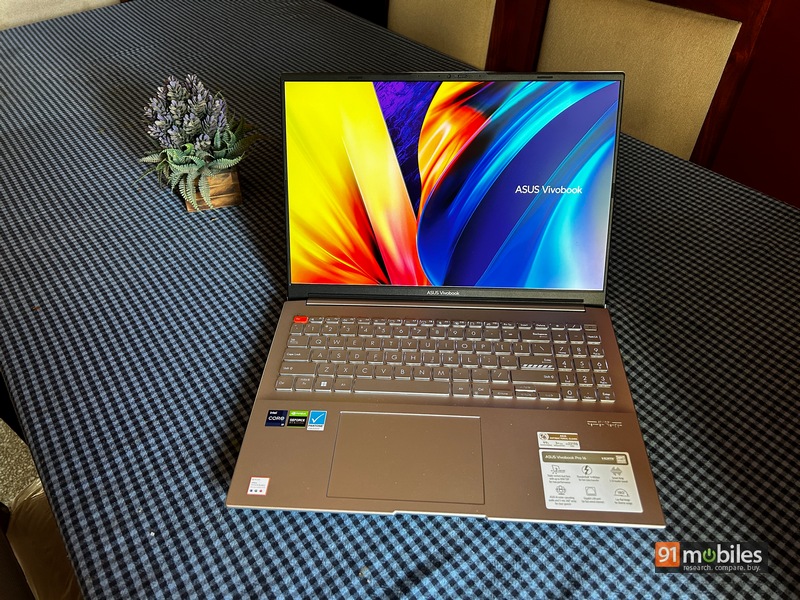ASUS announced the Vivobook Pro 15 and 16 models for consumers last year, and it looks like it has taken some time for the devices to reach the Indian market. I have with me the 16-inch version which is priced at Rs 99,990 and is powered by the 11th-gen Intel i9 11900H SoC. Two years ago, the silicone would definitely be top-end, but the 13th-gen Raptor Lake lineup is on the horizon now. That said, the Vivobook Pro 16 OLED is no slouch either and in this review let’s find if the laptop can give you the bang for your buck.
The lowdown

The overall build quality on the Vivobook Pro 16 is quite good and doesn’t need too much improvement. While being slightly on the heavier side at nearly 2kg, the laptop is largely portable and fits snuggly in my backpack. The anodised silver finish across the chassis looks premium and the hinge is sturdy enough while also allowing a tilt of 180 degrees. I also like how little flex there is at the centre of the keyboard which can be attributed to the overall sturdy construction. Vivobook’s branding is prominent and slightly raised from the lid’s back.
Talking about ports, the right edge sees an HDMI 2.1 port, an RJ45 Ethernet slot, and two Thunderbolt 4-capable USB Type-C outlets while on the right is a 3.5mm headphone jack, USB 3.2 Type-A port, and an SD card slot. Wireless connectivity options included on the laptop are Wi-Fi 6 and Bluetooth 5.0.

In the display department, the laptop has a 16-inch 120Hz WUXGA (2.8K) display that is of the IPS LCD variety. As per ASUS, the screen has a peak brightness of 300nits, 87 percent screen-to-body ratio, and can output 100 percent of Adobe’s sRGB color gamut. From my usage indoors, the visual experience on the device was decent enough. Although the panel is not really optimal for colour correction or photo editing work, it should suffice for casual content consumption.

The keyboard and touchpad on the Vivobook Pro 16 are quite utilitarian and match the chassis’ colour scheme. You get standard six-row chiclet-style keys that have shallow travel but can become slightly noisy while typing. During my usage, including typing out this review, I never had any issues with respect to response or latency on the keyboard. There’s a three-stage white backlight available for typing in dim environments. The power button also comes integrated with a fingerprint sensor thanks to Windows Hello support. On the touchpad, there’s plenty of room for your fingers, but the multi-finger and gesture support are not up to the mark. I would recommend attaching an external mouse to get more intensive work done.
Coming now to the performance aspects of the device, the Vivobook Pro 16 comes in a single Intel i9 11900H variant. This is a 10nm, octa-core chipset with 16 threads and a total TDP draw of 45W. Thanks to several vents, the device’s thermal envelope is rarely breached, though that can change with more graphically demanding tasks. Apart from this, the laptop has 16GB of DDR4 RAM and a 512GB PCIe Gen 3 SSD.
The benchmark numbers are satisfactory with Geekbench 5 outputting a multi-core score of 7,530. The Cinebench R23 result is slightly higher at 10,472 but at the pricepoint of the Vivobook Pro 16, I think you can get better numbers. I feel that upcoming Intel 13th-gen Razor Lake-powered machines will be more power efficient and powerful than the Vivobook Pro 16. However, I would also like to point out that when it comes to your regular day-to-day workloads like Chrome and Microsoft Office usage, you are going to face absolutely no problem.

On the GPU side of things, the RTX 3050 gets the benefits of ASUS’ MUX switch that, without going into too much detail, helps in power efficiency and better graphics. I ran a few games like CS: GO, Valorant, and Apex Legends to test out the capabilities of the machine. I was quite satisfied with the frame rates I saw, and also impressed with the cooling mechanism being employed. However, I wouldn’t count on running graphic-intensive AAA titles on the laptop without suffering from jittering gameplay.

Other aspects of the device include Harman/Kardon-backed dual speakers which sound quite pleasant. The 1080p webcam is decent enough to get you through your video calls and the fingerprint sensor works as advertised. In terms of battery life, the Vivobook Pro 16 has a 70Whr battery that can charge at 150W through the adapter provided within the box. Based on my usage of the laptop, I got just about four hours of screen-on time, which I think is subpar.
Verdict

I think the Vivobook Pro 16 is a great machine for office or college work. The laptop doesn’t break a sweat in any of the moderate-level tasks and offers a good media consumption experience, both visually and auditorily. However, the processing hardware on the device seems a bit dated and the battery life is none too great. Even so, furnishing the Intel i9 H series chipset for under Rs 1 lakh is quite a decent deal. The Vivobook Pro 16 gets my recommendation as a capable workhorse.
Editor’s rating: 3.5 / 5
Pros:
- Sturdy construction
- Good display
- Decent speakers
- Satisfactory keyboard
Cons:
- Dated processor
- Average battery life
The post ASUS Vivobook Pro 16 review: a competent workhorse first appeared on 91mobiles.com.
0 Comments